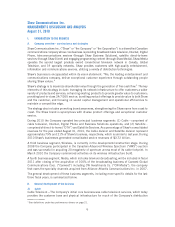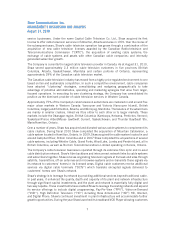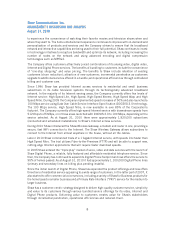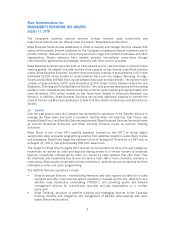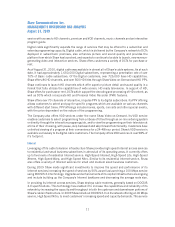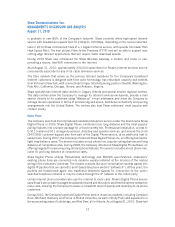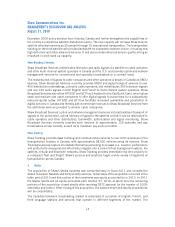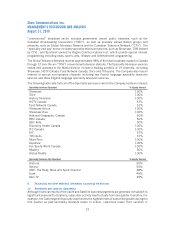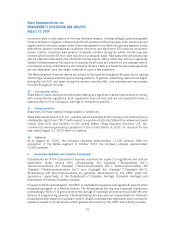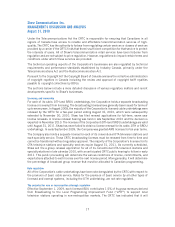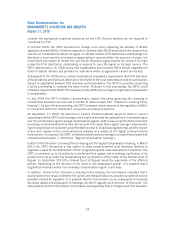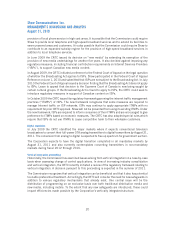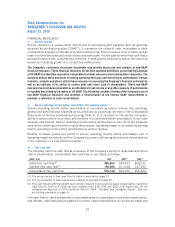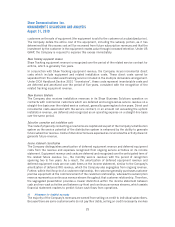Shaw 2010 Annual Report Download - page 20
Download and view the complete annual report
Please find page 20 of the 2010 Shaw annual report below. You can navigate through the pages in the report by either clicking on the pages listed below, or by using the keyword search tool below to find specific information within the annual report.reconnect cable in anticipation of the new television season. Correspondingly, subscriber growth
tends to be lower or negative in the third and fourth quarters as the school year ends, vacation period
begins and the television season ends. Subscriber growth in the Satellite business segment is also
affected by vacation schedules as customers reconnect and disconnect DTH services at summer
homes. Further, customers who vacation in warmer climates during the winter months may also
connect and reconnect DTH or cable services on a seasonal basis. New subscriber activations may
also be positively affected by the Christmas holiday season. While subscriber activity is generally
subject to these seasonal fluctuations, it may also be affected by competition and varying levels of
promotional activity undertaken by the Company. Shaw’s Cable and Satellite businesses generally
are not dependent upon any single customer or upon a few customers.
The Media segment financial results are subject to fluctuations throughout the year due to, among
other things, seasonal advertising and viewing patterns. In general, advertising revenues are higher
during the fall (Q1) and lower during the summer months (Q4), and expenses are more evenly
incurred throughout the year.
(b) Environmental matters
Shaw has not made, and does not anticipate making, any significant capital expenditures to comply
with environmental regulations. Such regulations have not had, and are not expected to have, a
material effect on the Company’s earnings or competitive position.
(c) Foreign operations
Shaw does not have material foreign assets or operations.
Shaw Business Solutions U.S. Inc., a wholly-owned subsidiary of the Company, has entered into an
indefeasible right of use (“IRU”) with respect to a portion of a United States fibre network and owns
certain other fibre and facilities in the United States. Shaw Business Solutions U.S. Inc.
commenced revenue-generating operations in the United States in 2002. Its revenues for the
year ended August 31, 2010 were not material.
(d) Employees
As at August 31, 2010, the Company employed approximately 11,000 persons. After the
acquisition of the Media segment in October 2010 the Company employs approximately
13,000 persons.
E. Government regulations and regulatory developments
Substantially all of the Corporation’s business activities are subject to regulations and policies
established under various Acts (Broadcasting Act (Canada) (“Broadcasting Act”),
Telecommunications Act (Canada) (“Telecommunications Act”), Radiocommunication Act
(Canada) (“Radiocommunication Act”) and Copyright Act (Canada) (“Copyright Act”)).
Broadcasting and telecommunications are generally administered by the CRTC under the
supervision, respectively, of the Department of Canadian Heritage (Canadian Heritage) and
Department of Industry (Industry Canada).
Pursuant to the Broadcasting Act, the CRTC is mandated to supervise and regulate all aspects of the
broadcasting system in a flexible manner. The Broadcasting Act requires broadcast distribution
undertakings (“BDUs”) to give priority to the carriage of Canadian services and to provide efficient
delivery of programming services. The Broadcasting Act also sets out requirements for television
broadcasters with respect to Canadian content. Shaw’s businesses are dependent upon licenses (or
operate pursuant to an exemption order) granted and issued by the CRTC and Industry Canada.
16
Shaw Communications Inc.
MANAGEMENT’S DISCUSSION AND ANALYSIS
August 31, 2010


